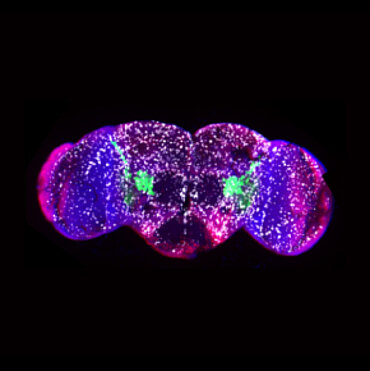Drosophila uncovers a novel transcriptional cascade that combats inflammation and is conserved in evolution
In a study published in the journal Cell Reports, IGBMC scientists discover an evolutionarily conserved anti-inflammatory transcriptional cascade from Drosophila to humans. The lack of the Gcm transcription factor leads to an increased response in chronic inflammatory states such as aging as well as in acute inflammatory states, such as in patients affected by multiple sclerosis. This work was conducted in collaboration with a team from the ICM (Paris).

The innate immune response is an ancestral process that can induce pro- and anti-inflammatory states. An adequate response to inflammation is fundamental because it allows the body to react to insults in an appropriate manner, neither too much nor too little, any imbalance being harmful. Chronic inflammation is also typical of aging, and an inflammatory state is associated with many human pathologies, from neurodegenerative diseases to cancer. One of the major challenges now is to identify transcriptional cascades that modulate the simultaneous expression of several effector genes, thus regulating the intensity of the response to inflammation.
Through this study, scientists have identified an evolutionarily conserved anti-inflammatory cascade. They demonstrate that, in Drosophila, the expression of the transcription factor Gcm/Glide is induced in immune cells after an acute challenge and also in cells closely associated with the aged brain (chronic inflammatory state). Similarly, they show that expression of the murine orthologous gene mGcm2 is specifically induced in microglia, which are the resident macrophage population of the nervous system. These cells are closely linked to neurodevelopmental, cognitive and neurodegenerative pathologies as well as to tumors of the nervous system. Consistent with the anti-inflammatory role shown in Drosophila, in mGcm2 deficient mice the aged microglia are in an inflammatory state. Moreover, when these mutant mice are subjected to an acute inflammatory challenge such as injection of lysophosphatidylcholine (LPC) into the spinal cord, they mount a much greater inflammatory response than control animals and mGcm2 expression is induced in the lesion. Finally, in patients affected by the inflammatory and demyelinating disease called multiple sclerosis, the expression of the transcription factor hGCM2 is observed specifically in the regions where inflammation is ongoing, the active plaques.
This study has a multidisciplinary dimension, with the use of vertebrate and invertebrate models as well as human port-mortem material. This work of interest in fundamental and evolutionary biology also brings an original contribution to medical research on a process that is still poorly understood. The identification of a transcription factor with anti-inflammatory action shows the importance of simple animal models, in which the genetic tools are very sophisticated. This work now allows us to understand how the Gcm cascade works and to consider screens to identify new molecules of therapeutic interest. These can then be tested in mammalian models closer to humans, in compliance with the European Three Rs rule (Replacement, Reduction, Refinement).
In patients affected by the demyelinating and inflammatory disease called multiple sclerosis, expression of the transcription factor hGCM2 is specifically induced in active plaques, where the inflammatory response is present. In aged mice that are defective for the orthologous factor mGcm2 specifically in brain macrophages called microglia, these cells are in an inflammatory state. In Drosophila, larvae infested by a parasitoid wasp induce an inflammatory response involving the proliferation of immune cells that form so-called melanotic masses. In animals defective for the Gcm/Glide factor, the inflammatory response is increased compared to what is observed in control animals (more melanotic masses), whereas in animals in which this factor is overexpressed, the response is less strong (less melanotic masses).
